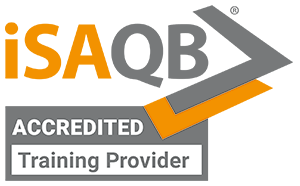iSAQB CPSA Advanced Level
iSAQB CPSA-A training at the ITech Academy
The advanced training program deepens your knowledge in the competence areas of methodology, technology and communication. You can collect the 70 credit points required for certification as a “Certified Professional for Software Architecture – Advanced Level (CPSA-A ®)” in various modules. Advanced Level certification requires the prior completion of the Foundation Level. Even for software architects who are not seeking certification, all advanced modules are of great value for their daily work.
Training with the best expertise
At the Advanced Level, we offer you a selection of 17 modules that can be selected based on your area of interest. From flexible architecture models to domain-driven design and important soft skills, you will find all the relevant and current topics from the world of software architecture here.
Select the CPSA Advanced Level training course of your choice from the following overview to access further information, open training dates and booking.


Do you have any questions?
We are happy to advise you by phone:
+49 621 595702 41
We are constantly monitoring current developments and, taking into account the official recommendations, remain flexible for you! You can read about our hygiene measures for face-to-face training here. Would you like to continue working remotely? Then you can access our online training courses here.
Architecture Documentation (ADOC)
How do you document and communicate software architectures?
20 CP Methodical
Agile software architecture (AGILA)
How can you effectively do architectural work in agile teams and projects?
20 CP Methodological,
10 CP Communicative
Architecture Evaluation (ARCEVAL)
How do you find out if an architecture meets expectations?
20 CP methodical.
Consensus in decentralized applications (BLOCKCHAIN)
How can blockchain technologies be used to achieve consensus in distributed, untrustworthy systems?
20 CP Technical,
10 CP Methodological
Infrastructure, Containers, and Cloud Native (CLOUDINFRA)
How are adaptable infrastructures for the cloud designed & implemented?
20 CP Technical,
10 CP Methodical
Domain Driven Design (DDD)
How do you design a business architecture in collaboration with subject matter experts and developers?
20 CP Methodical,
10 CP Communicative
Enterprise Architecture Management (EAM)
How can you keep a large landscape of IT systems and applications consistent?
30 CP Methodical
Embedded Systems (EMBEDDED)
How do you design embedded systems, i.e., those that have a direct impact on their environment?
20 CP Technical, 10 CP Methodical
Flexible Architecture Models (FLEX)
How do you design particularly flexible architectures?
20 CP Technical, 10 CP Methodical
Functional Software Architecture (Funar)
How does software architecture work with functions, immutable data, and combinators?
20 CP Technical, 10 CP Methodical
Green Software – Development of Resource-Efficient Applications(GREEN)
How do you design software architectures that save resources and energy in the long term?
10 CP Technical, 10 CP Methodical
Evolution & Improvement of Software Architectures (IMPROVE)
How do you systematically improve software systems, aligned with economic and technical goals?
10 CP Technical, 20 CP Methodical
Requirements for Software Architects (REQ4ARC)
How do you equip architects with sufficient requirements engineering knowledge so that they can make informed architectural decisions?
10 CP Communicative,
20 CP Methodical
Soft Skills for Software Architects (SOFT)
How can architects lead, moderate, and present architecture discussions clearly?
30 Communicative
Software Architecture for AI Systems (SWARC4AI)
How do I design and integrate high-performance, scalable, and future-proof AI systems into existing IT landscapes, meeting the highest standards of compliance, security, and maintainability?
20 CP Technical, 10 CP Methodical
Web Architectures (WEB)
How do you design high-performance and secure web-based systems?
30 CP Technical
Web Security (WEBSEC)
What does “Security” mean in the context of web applications, and how can it be integrated into your own analysis and development processes?
20 CP Technical, 10 CP Methodical
